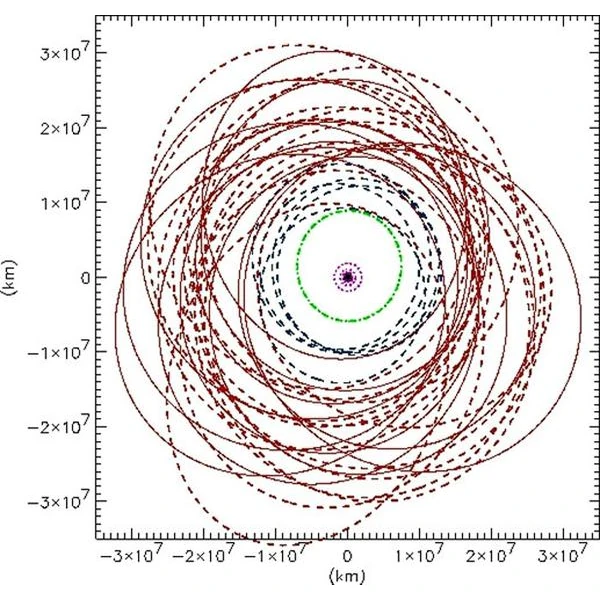
In 2023, astronomers announced the discovery of 12 new moons around Jupiter, bringing the total to 95 natural satellites confirmed by the International Astronomical Union (IAU). This number is still far from the number of moons of Saturn (146 confirmed moons), which holds the record. These new moons, mostly irregular, small (less than 3 km in diameter), and very distant from the planet, are predominantly retrograde, meaning they orbit in the opposite direction to Jupiter's rotation. This orbital asymmetry strongly indicates a non-native origin, through gravitational capture of objects from the Kuiper Belt or the inner Oort Cloud.
Irregular moons offer a unique window into the dynamic mechanisms of the outer solar system. Their eccentric orbits, high inclinations, and distribution into orbital families suggest past collisions and processes of aggregation or fragmentation. They are dynamic fossils that allow us to trace the gravitational history of the solar system. The study of these objects fuels numerical models describing the formation of Jupiter and its interactions with the protoplanetary disk, planetary migrations (such as that of Neptune), and waves of interplanetary object captures.
Detecting Jupiter's moons is an extremely complex task, especially when it comes to very small satellites, often referred to as "invisible moons." Although Jupiter gravitationally dominates its environment, detecting its minor satellites requires a combination of advanced observation technologies, sophisticated algorithmic processing, and astronomical patience.
The main difficulties lie in the low apparent magnitude of these objects: with diameters sometimes less than 1 km and very dark surfaces, these moons reflect little sunlight, making direct observation almost impossible without long exposure times. Moreover, their visual proximity to Jupiter is a major challenge, as the intense brightness of the planet produces light halos that saturate CCD detectors, masking the faint signals from the moons.
Irregular moons often move in highly eccentric, inclined, or retrograde orbits, complicating tracking and orbital confirmation. An object observed only once can easily be lost in the stellar background if its trajectory is not accurately reconstructed over several weeks. This is why the detection of new moons now involves repeated campaigns, often spaced several months apart, with wide-field telescopes such as Subaru (Hawaii), Magellan (Chile), or Blanco (CTIO).
Modern relative motion detection algorithms allow extracting coherent orbital trajectories from scattered data. This painstaking work has led to the discovery of dozens of small moons between 2017 and 2023. Nevertheless, researchers estimate that there are still dozens, if not hundreds of unknown moons around Jupiter, mainly beyond 25 million km, where the planet's gravity blends with the influence of the Sun.
Invisible moons are not just mysterious objects: they are witnesses to gravitational capture phenomena, collisional fragmentation, or ancient dynamic episodes that have shaped Jupiter's history. Their progressive census allows for a better understanding of the nature and evolution of the circum-Jovian environment and, more broadly, the processes of planetary formation in the solar system.
The solar system, long considered a stable and well-known entity, is now at the heart of a dynamic of discoveries that are revolutionizing our understanding of its composition and evolution. This celestial architecture, composed of the Sun, eight planets, their natural satellites, asteroids, comets, and interplanetary dust, is in reality a constantly evolving system. To date, more than 250 moons have been officially confirmed around the planets of the solar system, with a total that continues to grow thanks to observational advances. Saturn leads with its 146 confirmed natural satellites, followed by Jupiter with about 95 moons. Uranus and Neptune have about fifty and thirty moons, respectively, while terrestrial planets like Mars and Earth have a few. These satellites vary in size, composition, and origin, some being true bodies formed in situ, others gravitationally captured.
The solar system formed about 4.6 billion years ago from the gravitational collapse of a molecular cloud. This process generated a protoplanetary disk around the proto-Sun, where matter gradually agglomerated to form the planets, satellites, and small bodies. This formation phase was characterized by intense gravitational interactions, collisions, and orbital migrations, initiating a complex dynamic that continues to this day.
Technological advancements, particularly in observational astronomy, have enabled the detection of hundreds of new objects. For example, the recent discovery of 12 new moons around Jupiter reveals significant gravitational capture activity and a dynamic environment. Furthermore, trans-Neptunian objects, located beyond Neptune, are increasingly being cataloged, indicating a formation and interaction zone that is still poorly understood.
Current models show that the giant planets, particularly Jupiter and Saturn, migrated during the first few million years of the solar system. These migrations altered the distribution of small bodies, caused instabilities, and likely triggered intense bombardments on the terrestrial planets, a key event in the geological and biological history of Earth. This complex dynamic continues to be studied through numerical modeling and observation of orbital perturbations.
Studies of the solar system provide an essential reference framework for understanding the diversity of planetary systems observed in our galaxy. The ongoing revision of its architecture invites us to reconsider the models of planetary formation and the dynamic processes that can shape these systems, with implications for the search for life elsewhere in the universe.